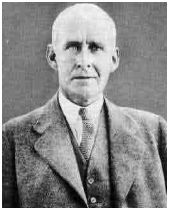
Biografia estratta da: http://www.usd.edu/ a cura di Clark Bennett
Sir Arthur Eddington was one of the most prominent and important astrophysicists of his time. He made several significant contributions to the area of physics. He was one of the first physicists who understood the early ideas of relativity along with Albert Einstein. Arthur Eddington was born on December 28, 1882 in Kendal, England. He never had an opportunity to know his father who died when Arthur was about two years old. He always kept to his Quaker religion and never took part in active conflicts (such as the upcoming WWI). Throughout his high school and college careers, he was awarded several scholarships. He attended Owens College where he studied the fields of physics and mathematics until he graduated in 1902. In 1907, Eddington was awarded a fellowship to Trinity College and was named a Smith's Prize winner for his various accomplishments in research. From the years 1906 to 1913, he was the primary assistant at the Greenwich Royal Observatory. Later in 1913, he accepted a position as an astronomy professor at Cambridge.
Then in 1914, he became a full member of the Royal Society. As he studied at Cambridge between 1914 and 1918, he became more knowledgeable in the area of relativity. It can be easily stated that only Arthur Eddington and Albert Einstein had a full understanding of relativity for approximately a decade. He became Sir Arthur Eddington in 1930. He spent a great deal of his remaining years critiquing the work of his colleagues in astrophysics. His most famous battle was the one with Subrahmanyan Chandrasekhar over the constitution of white dwarf stars. Eddington severely criticized the work of Chandrasekhar although his own ideas were outdated and incorrect. Other physicists silently backed Chandrasekhar but did not publicly discredit the great Eddington. Sir Arthur Eddington died on November 22, 1944 in Cambridge, England. Eddington made significant contributions to the area concerning general relativity and astrophysics.
Eddington can be called the "Father of Modern Theoretical Astrophysics." He published several books that helped to expand these areas including "Mathematical Theory of Relativity" which Einstein referred to as the best publication in this area. He studied the properties of a solar eclipse on various expeditions around the world. This research eventually confirmed Albert Einstein's theory that as light passes a very massive star, its path is bent due to gravity. Eddington spent a great amount of time researching the internal makeup of stars. One of his findings in this field was that the scattering of electrons is the primary source of the opacity of stars. Along with this finding, he also determined that a star's luminosity if finite for a supplied mass. The divisor of the inequality for finding a star's maximum luminosity is now called the Eddington Limit. These findings were published in 1926 in his book "The Internal Constitution of Stars." This limit is currently utilized in research on finding the sources of x-rays and black hole characteristics. Both he and Albert Einstein created arguments against the existence of black holes, which were subsequently disproved in the 1950s. Also, Eddington fought Chandrasekhar's idea of an upper limit for the mass of a white dwarf star.
However, his argument was incorrect, and the Chandrasekhar Limit for the mass of a white dwarf still stands today as the correct way of determining the upper bound for the mass of a white dwarf. In spite of some of his mistakes, Arthur Eddington made a great deal of valuable additions to the scientific community. Eddington was one of the earliest creators of the concept of relativity. He helped to confirm some of Einstein's work and make valuable additions to the area. Though he was very hostile to the views of some of his colleagues in his later life, he was truly a brilliant physicist.
![]()